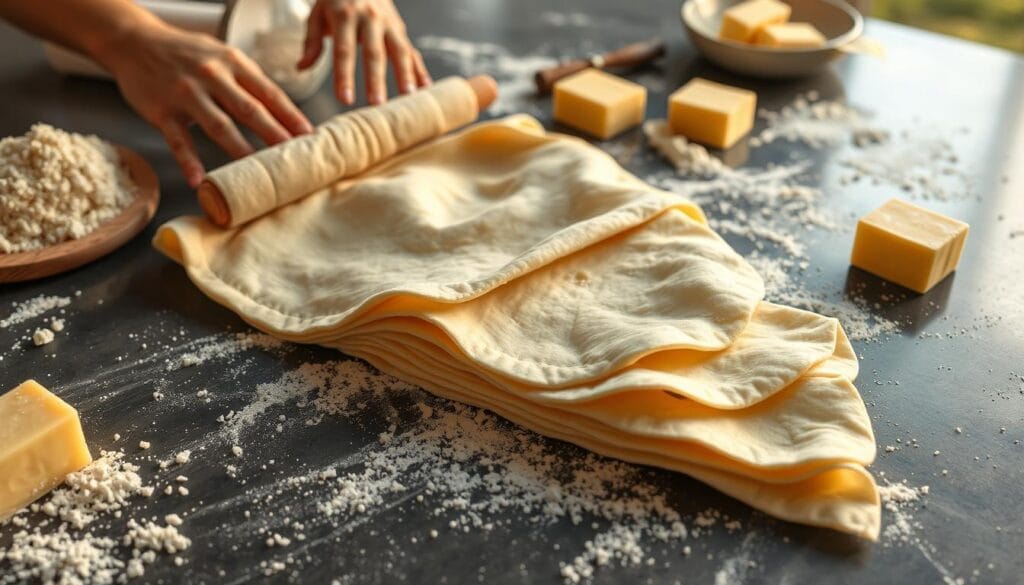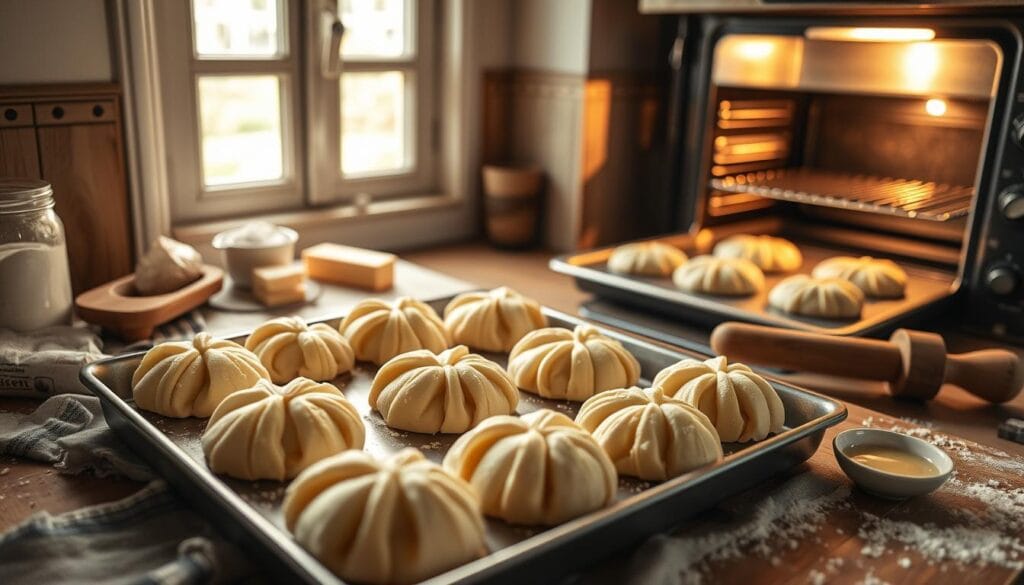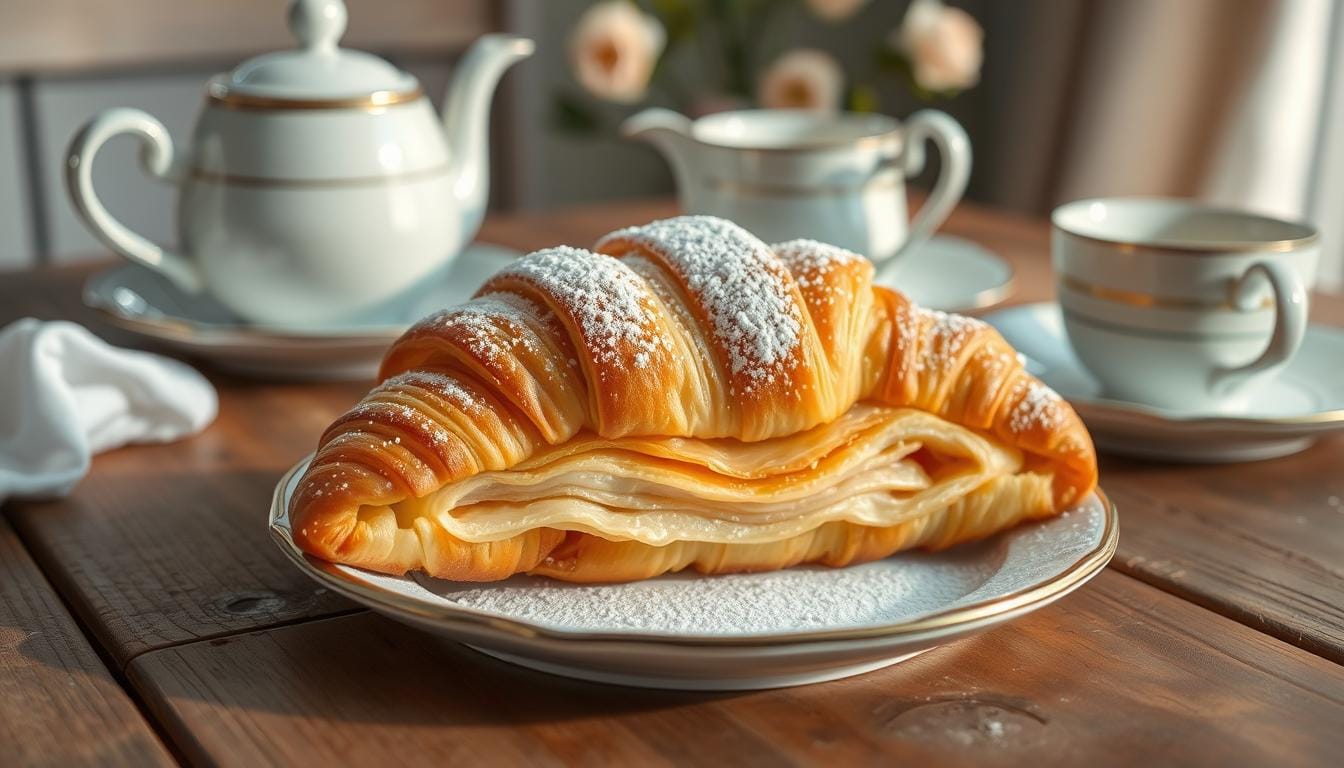Imagine waking up to the smell of freshly baked Swiss gipfeli recipe. This crescent-shaped pastry turns a simple morning into a journey of flavors. It’s like a trip to the Swiss Alps without leaving your kitchen.
The gipfeli recipe is more than a bread; it’s a cultural treasure. Unlike the French croissant, it has a firmer texture and richer taste. Its flaky layers and buttery flavor make it a true Swiss delight.
If you love baking or want to try authentic Swiss food, this guide is for you. You’ll learn how to make the most delicious gipfeli ever. Get ready to discover the secrets of this beloved pastry and improve your baking skills.
Understanding Swiss Gipfeli Recipe: A Traditional Swiss Pastry
Explore the world of gipfeli, a beloved Swiss pastry. It shows the deep culinary roots of Switzerland. These flaky pastries are more than breakfast – they’re a piece of Swiss culture and tradition.
Origins and Cultural Significance
The gipfeli started in the early 19th century, linked to the Austrian Kipferl. This crescent-shaped treat became a key part of Swiss life.
- Originated in early 19th-century Switzerland
- Linked to Austrian pastry traditions
- Represents authentic Swiss culinary craftsmanship
Differences Between Gipfeli recipe and French Croissants
| Characteristic | Gipfeli | French Croissant |
|---|---|---|
| Texture | Slightly denser | Lighter and airier |
| Butter Content | Lower butter percentage | Higher butter percentage |
| Fat Content | 82% butter fat | Higher fat percentage |
The Swiss Breakfast Tradition
Gipfeli are a key breakfast item in Switzerland. They’re best with coffee or tea. These pastries are more than breakfast – they’re a cultural tradition that brings families together.
- Served with coffee or tea
- Part of daily Swiss breakfast ritual
- Enjoyed across different age groups
Essential Ingredients for Authentic Gipfeli Recipe
To make the perfect gipfeli, start with the right ingredients. These Swiss pastries are special because of their exact mix of ingredients. This mix gives them their flaky texture.
Learning to make gipfeli means knowing the key ingredients. Here’s a detailed list of what you’ll need:
- Flour: Use high-quality all-purpose flour (500g) as the base of your gipfeli
- Yeast: Active dry yeast (7g) is key for the right rise
- Butter: Cold unsalted butter (250g) is vital for flaky layers
- Milk: Warm milk (250ml) helps activate the yeast and adds richness
The secret to great gipfeli is in the quality and temperature of your ingredients. Cold butter is crucial for those flaky layers. It’s what makes gipfeli so tempting.
| Ingredient | Quantity | Purpose |
|---|---|---|
| All-Purpose Flour | 500g | Provides structure and texture |
| Active Dry Yeast | 7g | Enables proper rising and flavor development |
| Cold Unsalted Butter | 250g | Creates flaky, layered texture |
| Warm Milk | 250ml | Activates yeast and adds moisture |
Pro tip: Make sure your yeast is fresh and your butter is very cold. These two are essential for the real Swiss gipfeli experience. They give it that flaky texture.
The Art of Lamination: Creating Perfect Flaky Layers
Making real gipfeli means learning the lamination trick. This method turns simple stuff into a pastry with flaky layers that fall apart in your mouth.

The key to flaky layers is knowing how to mix butter and dough right. It’s all about keeping the right temperature and using the right techniques.
Mastering the Butter Layer Technique
For the best butter block, pick butter with 82-86% fat. It should be between 52 to 61°F. This makes it soft but not melted.
- Use a rolling pin on a floured surface to create an even butter layer
- Wrap the dough in plastic to maintain consistent temperature
- Keep butter cold throughout the lamination process
Temperature Control During Folding
When folding the dough, keep it cool. Aim for 36 to 43°F. This stops the butter from spreading too much.
Achieving the Perfect Dough Consistency
Getting flaky layers takes time and care. Let your dough rest for 10-15 minutes after each fold. This relaxes the gluten and makes rolling smoother.
- Use unbleached all-purpose flour for best results
- Mix dough at low speed for approximately 3 minutes
- Allow dough to rest overnight in the refrigerator
With practice, you’ll get better at making gipfeli. You’ll create pastries with crisp, flaky layers that show off Swiss pastry art.
Step-by-Step Gipfeli Recipe
Ready to make gipfeli like a true Swiss baker? This recipe will guide you through making delicious, flaky pastries. You’ll feel like you’re in Switzerland. Let’s start making authentic gipfeli dough!
Ingredients You’ll Need
- 500g all-purpose flour
- 250ml warm milk
- 50g sugar
- 7g active dry yeast
- 1 tsp salt
- 250g cold unsalted butter
- 1 egg
Begin by preparing your gipfeli dough. Mix warm milk, sugar, and yeast in a bowl. Let it sit for 5-10 minutes until frothy. This step is crucial for a beautiful rise.
Knead flour and salt together, adding the yeast mixture slowly. Work the dough until it’s smooth and elastic. Patience and technique are key here.
Let the dough rest in a warm place for 30-45 minutes. It’s ready when it doubles in size. This step develops the gluten for flaky layers.
Preheat your oven to 200°C (390°F). Roll out the dough and create butter layers by folding and turning. This makes gipfeli flaky and irresistible.
Shape into crescent shapes and brush with egg wash for shine. Bake for 15-20 minutes until golden brown.
Pro tip: The ideal proofing temperature is between 24°C and 26°C (75°F to 78°F) for perfect rise and texture.
Your homemade gipfeli are ready! Enjoy them warm with butter and jam for a Swiss breakfast.
Shaping and Forming Traditional Crescent Rolls
Creating crescent-shaped gipfeli is all about precision and skill. It turns a simple rectangle of dough into beautiful pastries. These pastries are a treat for the eyes and taste buds.
Classic Crescent Shape Technique
To get the perfect crescent shape, start with a large rectangle of dough. It should be 24 inches by 12 inches. Here’s how to do it:
- Use a sharp knife to cut the dough into triangles
- Mark 3.5-inch intervals on the long sides of the rectangle
- Cut 12 precise triangles from the dough
- Make a small 1.5 cm notch at the center base of each triangle
Tips for Even Size and Appearance
To make uniform gipfeli, pay close attention to detail:
- Elongate each triangle to approximately 25 cm
- Roll each triangle gently from the base towards the point
- Ensure each crescent is about 13 inches long
- Space croissants at least 2 inches apart on baking sheets
Common Shaping Mistakes to Avoid
Be careful of these common mistakes when shaping your crescent pastries:
- Avoid stretching the dough too thin
- Maintain consistent triangle sizes
- Keep the dough cool during shaping
- Don’t rush the rolling process
Pro tip: Practice makes perfect when creating these delicate, crescent-shaped delights!
Proofing and Baking Techniques

Making perfect gipfeli needs two key steps: proofing and baking. These steps turn simple dough into a flaky, golden treat. It’s all about mastering these techniques.
Proofing Your Gipfeli recipe
For proofing, keep your gipfeli in a warm spot. Put them on a baking sheet lined with parchment paper. Cover them with a towel. Let them rest for 30 minutes until they puff up.
- Optimal proofing time: 1-2 hours
- Dough should nearly double in size
- Ideal temperature: Warm, draft-free area
Baking to Perfection
Heat your oven to 375°F (190°C). Before baking, brush the tops with a beaten egg. This makes them golden brown, just like in a bakery.
- Baking temperature: 375°F (190°C)
- Baking time: 18-22 minutes
- Look for puffy, layered appearance
After baking, let them cool a bit on a wire rack. This step sets the layers and makes the outside crisp. Your homemade gipfeli are now ready to enjoy!
Pro tip: The key to amazing gipfeli is patience during proofing and careful attention during baking.
Sweet and Savory Filling Variations
Explore a world of delicious fillings to elevate your gipfeli experience. Whether you like sweet or savory, there are many ways to enjoy gipfeli.
Gipfeli can be filled with exciting options. From traditional Swiss recipes to modern twists, you can make gipfeli your own.
Traditional Swiss Fillings
Classic Swiss gipfeli have simple yet delightful fillings. These honor the pastry’s rich heritage. Here are some traditional options:
- Chocolate chips (up to 50% filling)
- Almond paste
- Swiss cheese blends like Gruyère and Emmental (30% filling content)
Modern Flavor Combinations
Innovative bakers are creating new savory gipfeli fillings. These add excitement to the classic pastry:
- Ham and cheese
- Herb-infused cream cheese
- Roasted vegetable medleys
| Filling Type | Sweet/Savory | Flavor Intensity |
|---|---|---|
| Chocolate Chip | Sweet | High |
| Gruyère Cheese | Savory | Medium |
| Herb Cream Cheese | Savory | Light |
Special Occasion Variations
For festive moments, try these unique fillings. They can make your gipfeli recipe a memorable treat:
- Holiday-themed chocolate and spice fillings
- Seasonal fruit compotes
- Celebratory cream cheese and smoked salmon combinations
Remember, the key to an extraordinary gipfeli is experimenting. Try different fillings to find your perfect match!
Storage and Reheating Tips
Keeping your freshly baked gipfeli delicious is key. They taste best when warm. So, it’s important to know how to keep them flaky.
- Store in an airtight container at room temperature for up to 2 days
- Keep away from direct sunlight and heat sources
- Avoid storing in humid environments
Freezing is great for longer storage. Wrap each gipfeli in plastic or foil. Then, put them in a freezer-safe container. They stay good for up to 3 weeks in the freezer.
Reheating Techniques
To get your gipfeli recipe crispy and soft again, try these ways:
- Oven Method: Preheat to 300°F (150°C) and warm for 5-7 minutes
- Toaster Oven: Heat for 3-4 minutes until warm and crisp
- Air Fryer: Warm at 300°F (150°C) for 2-3 minutes
| Storage Method | Duration | Best Practice |
|---|---|---|
| Room Temperature | 1-2 days | Airtight container |
| Refrigerator | 3-4 days | Wrapped in plastic |
| Freezer | Up to 3 weeks | Individual wrapping |
Pro tip: Reheat gipfeli just before serving. Warm them gently to keep their flaky texture.
Conclusion
Making the perfect homemade gipfeli is an art. It needs precision, passion, and practice. This journey shows how to turn simple ingredients into flaky, buttery treats.
The best gipfeli recipe is about balance. It’s not just following steps. It’s about the right mix of ingredients and techniques.
Whether for breakfast or an afternoon snack, you can now make these pastries with ease. Remember, practice makes perfect. Each batch brings you closer to mastering this Swiss tradition.
Your kitchen is ready to make a pastry that celebrates Swiss baking. Enjoy the process, the buttery layers, and every bite of your homemade gipfeli.

